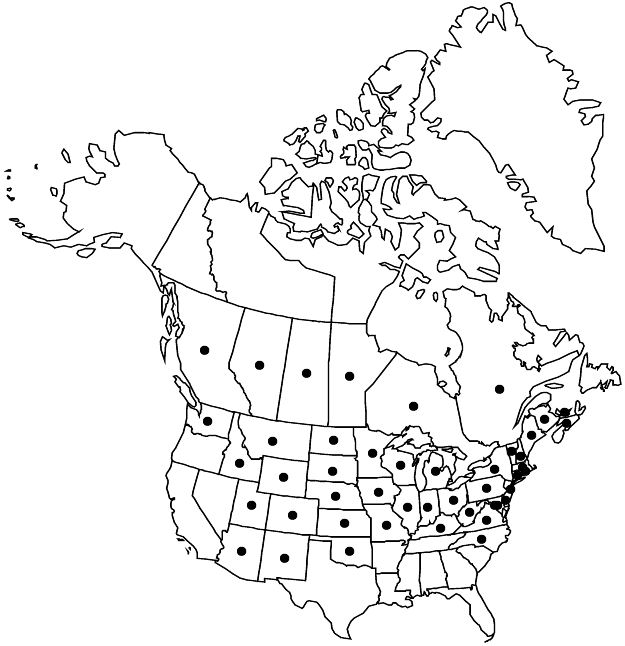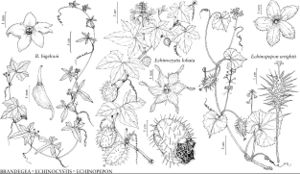Difference between revisions of "Echinocystis lobata"
Fl. N. Amer. 1: 542. 1840.
FNA>Volume Importer |
FNA>Volume Importer |
||
| Line 37: | Line 37: | ||
|elevation=0–2000 m | |elevation=0–2000 m | ||
|distribution=Alta.;B.C.;Man.;N.B.;N.S.;Ont.;P.E.I.;Que.;Sask.;Ariz.;Colo.;Conn.;Del.;D.C.;Idaho;Ill.;Ind.;Iowa;Kans.;Ky.;Maine;Md.;Mass.;Mich.;Minn.;Mo.;Mont.;Nebr.;N.H.;N.J.;N.Mex.;N.Y.;N.C.;N.Dak.;Ohio;Okla.;Pa.;R.I.;S.Dak.;Utah;Vt.;Va.;Wash.;W.Va.;Wis.;Wyo. | |distribution=Alta.;B.C.;Man.;N.B.;N.S.;Ont.;P.E.I.;Que.;Sask.;Ariz.;Colo.;Conn.;Del.;D.C.;Idaho;Ill.;Ind.;Iowa;Kans.;Ky.;Maine;Md.;Mass.;Mich.;Minn.;Mo.;Mont.;Nebr.;N.H.;N.J.;N.Mex.;N.Y.;N.C.;N.Dak.;Ohio;Okla.;Pa.;R.I.;S.Dak.;Utah;Vt.;Va.;Wash.;W.Va.;Wis.;Wyo. | ||
| − | |discussion=<p>Echinocystis lobata is sometimes cultivated in arbors for its showy white flowers (staminate) in long inflorescences. Its occurrence in the western United States is sporadic.</p> | + | |discussion=<p><i>Echinocystis lobata</i> is sometimes cultivated in arbors for its showy white flowers (staminate) in long inflorescences. Its occurrence in the western United States is sporadic.</p> |
|tables= | |tables= | ||
|references= | |references= | ||
| Line 61: | Line 61: | ||
|publication year=1840 | |publication year=1840 | ||
|special status=Endemic;Selected by author to be illustrated | |special status=Endemic;Selected by author to be illustrated | ||
| − | |source xml=https://jpend@bitbucket.org/aafc-mbb/fna-data-curation.git/src/ | + | |source xml=https://jpend@bitbucket.org/aafc-mbb/fna-data-curation.git/src/8f726806613d60c220dc4493de13607dd3150896/coarse_grained_fna_xml/V6/V6_25.xml |
|genus=Echinocystis | |genus=Echinocystis | ||
|species=Echinocystis lobata | |species=Echinocystis lobata | ||
Revision as of 17:46, 18 September 2019
Leaves: petiole 1–4 cm; blade 2–8(–12) cm, lobe apex acute, sinuses rounded, surfaces glabrous or slightly scabrous, hair bases pustulate. Inflorescences: staminate racemes 8–14 cm; pistillate peduncles 2–5 cm. Flowers lightly fragrant; corolla 8–12(–16) mm diam. Pepos 3–5 cm, spinules 4–6 mm, glabrous or slightly scabrous. Seeds 12–20 mm. 2n = 32.
Phenology: Flowering May–Sep(–Oct).
Habitat: Bottomland forests and thickets, riparian woods, marshes and marsh edges, thickets in pastures, fencerows, ditches, lake shores, railroad banks, dunes
Elevation: 0–2000 m
Distribution

Alta., B.C., Man., N.B., N.S., Ont., P.E.I., Que., Sask., Ariz., Colo., Conn., Del., D.C., Idaho, Ill., Ind., Iowa, Kans., Ky., Maine, Md., Mass., Mich., Minn., Mo., Mont., Nebr., N.H., N.J., N.Mex., N.Y., N.C., N.Dak., Ohio, Okla., Pa., R.I., S.Dak., Utah, Vt., Va., Wash., W.Va., Wis., Wyo.
Discussion
Echinocystis lobata is sometimes cultivated in arbors for its showy white flowers (staminate) in long inflorescences. Its occurrence in the western United States is sporadic.
Selected References
None.
